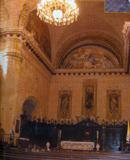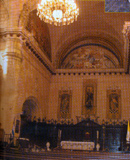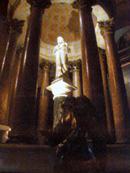The Havana Cathedral
Sitting majestically in Old Havana as part of its historic core –declared Heritage of Mankind by UNESCO in 1982- this is the main church of the Cuban capital. The Havana Cathedral is almost an obliged must-see for those who come to town. Tourists and travelers who attend events and meetings in Havana, pay a visit to this major cluster of colonial buildings that surround the old clobbered square in which the Cathedral stands out so beautifully, that the plaza was eventually named after it some time ago.
Trapped in a quasi-magical atmosphere, the outer structure of the church contemplates the bustling moves of people from all walks of life: tourists with cameras slung over their shoulders, artists and artisans that show off their works of art, troubadours that bring some cheerfulness to the premises with their music, bystanders, city slicks and islanders from elsewhere.
In a way, this view seems to somehow reflect the 19th-century scenery splayed in so many canvasses that past and present painters have used time and again as a genuine source of inspiration. Serving as a backdrop, the Cathedral and its superb baroque façade have also witnessed numerous performances, musical shows, operas, zarzuelas, dances and ballet presentations.
The construction of the temple –the flagship of Cuban baroque- started in 1748 under the leadership of Jesuits and it was supposed to be a school for missionaries. Later on, it was enhanced with the addition of a chapel and a monastery. In the second half of the 18th century, the Company of Jesus decided to build a prayer house on the premises, but the works were interrupted as the Order was kicked out of the island nation in 1767. In 1777, the Main Parish was set up there. A dozen years later in 1789, the church was anointed as a cathedral by Havana's Bishop Jose Felipe de Trespalacios y Verdeja. The name of the Cathedral's architect or designer still remains unknown. But truth is that master bricklayer Don Pedro de Medina led the final works until its completion. Up to that moment, the façade's overabundant baroque features had been similarly reproduced in the interiors, though to a lesser degree.
Bishop Trespalacios' successor, celebrated Bishop Jose Diaz de Espada y Fernandez de Landa –a heated enthusiast of the neoclassic style that picked up steam in the 19th century- introduced major changes inside the church. The stone floor was replaced by marble slabs and primitive altars were removed, among other modifications. Word had it that Bishop Fernandez was anything but a man of good taste. As outstanding Cuban architect Daniel Taboada Espiniella once put it, "Indeed, he tried to do away with every single baroque trace without affecting the church's architectural structure in order to make way for the new neoclassic elements."
Regardless of so many changes and transformations, the temple underwent other modifications in the interiors as time rolled on. On the eve of Pope John Paul II's historic visit to Cuba on January 1998, some major changes were made inside the Cathedral to assimilate the higher liturgy and as part of state-run efforts to restore the city. Architect Carlos Moret, with the help of the province's Monuments Commission and the Department of Heritage Architecture of the City Historian's Office –the latter is led by Dr. Eusebio Leal Spengler- oversaw the entire process.
In addition to its liturgical role and architectural values, the Havana Cathedral treasures priceless works of arts along its hallways. Some outstanding cases in point are the oleos of French painter Juan Bautista Vermay, the canvass with the Virgin of Loreto, the woodcarvings of San Cristobal (saint patron of Havana), and the Virgin of the Pure Conception, the Cathedral's holy keeper.
In the realm of spun yarns and anecdotes, the Havana Cathedral is part of the controversy over the mortal remains of Christopher Columbus. This is how the story goes: the Genovese admiral was first buried in Valladolid where he had died in 1506. On that same year, his son Diego moved the body to Seville. Diego Colon, who replaced Ovando as governor of La Hispaniola, passed away in 1526. His widow Maria de Toledo y Rojas took the remains of both his husband and Columbus to La Hispaniola, where they were buried in the Santo Domingo Cathedral. When Spain gave up the island to the French in 1795, a small box that allegedly contained the human remains of Christopher Columbus was sent to Cuba together with an assortment of other objects. That little box was reportedly buried in the Havana Cathedral.
But in 1877, a small funerary box labeled with the name of the Genovese admiral suddenly popped up in the Santo Domingo Cathedral. Inside the box, there were a few vertebra and bone fragments, plus a tiny silver plank reading: “Last or only remains of the First Admiral Don Christopher Columbus, the Discoverer.” The religious leader of the dioceses, Archbishop Rocco Cochia, announced those were the real relics of the admiral. The Royal Academy of History, at the instance of Canovas del Castillo, presented its own verdict: “The remains of Columbus are buried in the Havana Cathedral under the shadow of the glorious flag of Castile.” In 1898 when Spain left Cuba, the columbine remains were removed from the Havana Cathedral and shipped to Spain for a final burial in Seville. And they're still there. Some researchers toy with the possibility that the 1877 finding in Santo Domingo was just a scam and that the remains buried in Seville could probably be the real McCoy.
In short, history, art and anecdote are the basic components that draw travelers to visit the Havana Cathedral. Furthermore, let's not forget this is the only Cuban entry in the World Baroque Atlas, proposed in 1994 by the Baroque Spaces Program, a UNESCO project that involves over 40 countries.






































































